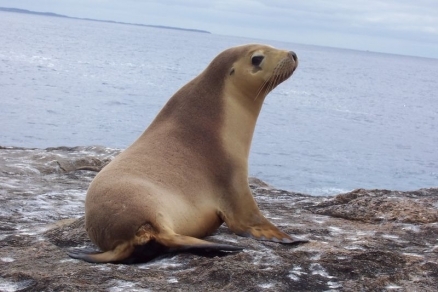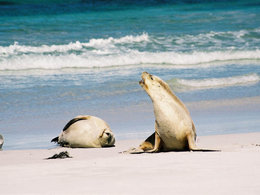Australian sea lion
The Australian Sea Lion (also White-capped Sea Lion; Scientific name: Neophoca cinerea) is one of 16 species of marine mammals in the family of eared seals which include sea lions and fur seals. Together with the families of true seals and Walruses, Eared seals form the group of marine mammals known as pinnipeds.
Eared seals differ from the true seals in having small external earflaps and hind flippers that can be turned to face forwards. Together with strong front flippers, this gives them extra mobility on land and an adult fur seal can move extremely fast across the beach if it has to. They also use their front flippers for swimming, whereas true seals use their hind flippers.
Australian sea lions are found on islands offshore of Australia, especially on Kangaroo Island and Dangerous Reef (near Port Lincoln) in southern Australia. The species is considered endangered and is protected.
|
Conservation Status |
|
Scientific Classification Kingdom: Animalia (Animals) |
Contents
Physical Description
Australian sea lions have a large head with a long, narrow, and tapered muzzle. The skull has a sagittal crest approximately 3 cm in height.
Australian sea lions exhibit a significant difference in the size of females and of males. As an adult, males grow to about 2.5 m and weigh 300 kg. Females grow to a length of about 1.8 m and weigh approximately 105 kg.
Males display a much larger head than females and juveniles, as well as significantly broader shoulders. Their pinnae, or ears, are incredibly small and lie close to the head. Juveniles are a dark brown with a pale crown and a dark facial mask.
Subadult males and females display a coat that is fawn to silvery-gray on top and tan to pale yellow on the bottom. Mature males are dark brown with a cream-colored crown and nape, and a paler chest and throat area.
At birth, pups are roughly 60 to 70 cm and weigh approximately 6.5 to 8 kg. Their pelage is initially chocolate brown, but is replaced by adult-like fawn colored fur by the age of two months.
Females reach sexual maturity at around 3 years of age, whereas males usually do not mature until they are 6 years of age or older. Males darken even further as they mature, and go through a transition phase where they have spots on their chests.
Reproduction
Australian sea lions have a breeding cycle of approximately 17.6 months. These non-annual cycles are affected by some unknown factor, not by environmental influence as previously thought. Some females do not produce young in consecutive breeding seasons. Births can occur over a period of 4-6 months in any colony of Australian sea lions, making births highly unsynchronized.
The mating system of this sea lion is polygynous. A male secures a breeding territory on the beach and actively defends it against other males though ritualized posturing and aggressive confrontation. The male leaves his territory to feed in the ocean for a few hours at a time. Upon his return, he may have to battle to regain his territory.
Males keep several females on their territories. Males have the ability to herd the females into mating groups, a feature rare in other species of sea lion. If the female strays, the male will aggressively herd her back, sometimes entering another male's territory to do so. When the breeding cycle begins, males copulate with harems of four or five females at a time.
Female Australian sea lions come to shore about two days before they give birth in order to establish a natal site.
Females enter estrous about 6 days after giving birth, and are mated by the male at this time. There is some debate in the literature about the ensuing gestation period. Pinnipeds typically experience a delay in implantation of about three months, followed by an eight or nine month placentation. Because Australian sea lions experience a much longer interbirth interval, it is clear that this species differs from the typical pinniped pattern. Some investigators think that Australian sea lions experience a longer than average dely in implantation of the blastocyst, amounting to 10-11 months, and a normal length pregnancy (8-9 months). Others think there is a more typical pinniped length delay in implantation (5-6 months) and a longer than average placentation (over 12 months).
After giving birth to a pup, the female will stay at the natal site for approximately 10 days before returning to the sea to forage. She will return to land every couple of days to nurse her young, staying with the pup for about 33 hours at a time. A mother uses both vocal and scent communication to locate and identify her pup.
As pups grow up, they often form small groups and swim in shallow rock pools before they venture into the ocean with their mothers.
Young are typically weaned about 26 days before giving birth to their next pup, at 15-18 months. However, some mothers have been seen nursing both a yearling and a newborn pup.
There are reports of females being aggressive to pups other than their own, but there are also some reports of females taking care of groups of pups. This makes it difficult to determine how much cooperative care of young there might actually be, although it is clear that some cooperative care occurs. Altricial at birth, pups are able to follow their mothers both on land and into the sea at approximately 3 months of age.
Males have been seen killing pups, although presumably not their own. Defense of territories may be an indirect mechanism of paternal care for young.
No specific male parental care has been reported for Australian sea lions, but by maintaining territories, fathers may protect their offspring from other males of the species.
Behavior
Australian sea lions are among some of the only pinnepeds that display “fostering behavior.” This is a form of altruism, as a female will nurse and protect the young of others at her own expense. In some cases, they will even adopt the young of others if the mother is killed. Some females living in the Seal Bay region have even displayed “babysitting behavior,” where a female will protect an entire group of pups even if they are not her own. When she gets tired, another female takes her place. However, it should be noted that there are also reports of females showing agonistic behavior toward pups that are not their own. It may be speculated that the familial relationship between females affects their behavior toward pups.
Males, on the other hand, are not at all protective of the pups, and will often engage in infanticide. They can sometimes be seen viciously attacking pups, often biting or shaking them to death. Males will also sexually harass groups of females, and engage in play behavior with other males.
Another behavior that members of the species exhibit is the practice of swallowing gastroliths (small stones). It is believed that they do this in order to balance their weight when diving for food. In the water, Australian sea lions has been seen at depths up to 40 meters.
Distribution
Australian sea lions are found on islands offshore of Australia. They range from western Australia to islands in southern Australia. The largest populations are found on Kangaroo Island and Dangerous Reef (near Port Lincoln) in southern Australia. The smallest numbers are found on the west coast of southern Australia and in Western Australia. Some live in Tasmania as well, but these are few in number. They once bred in the Bass Strait, but the entire population was wiped out by the sealing industry.
Habitat
Australian sea lions are non-migratory , so they live and breed on sandy beaches near their birth site in relatively large colonies. The greatest distance recorded for a tagged animal has been 300km from its birth site. During times of tumultuous weather, they will often travel inland to seek shelter in dunes and coastal vegetation. Unlike many pinnipeds, Australian sea lions are very capable out of the water, and have been found as far as 9.4 km inland. Many have been found at the tops of cliffs as high as 30 meters, as they are also excellent climbers.
Food Habits
Australian sea lions feed on a small number of fishes (which include whiting, rays, and small sharks), squid, cuttlefish, and fairy penguins (Eudyptula minor). The main diet of Australian sea lions consists of blue-throated wrasse (Notolabrus tetricus) and octopus. They concentrate on shallow-water benthic prey, and usually dive for food at depths no greater than 37 meters. This species is probably a component of control on fish and penguin populations.
One of the predators of the Australian sea lion is the great white shark (Carcharodon carcharias), especially near the Dangerous Reef region of the Port Lincoln area. Fishermen also occasionally kill them accidentally by entangling them in their nets. Historically, the population was greatly reduced due to sealing.
Conservation Status
Australian sea lions are fully protected within Australia. They are listed as “Endangered” on the IUCN Red List of Threatened Animals. Harvesting of this species is not allowed, and a permit is required for research or capture for zoos
Economic Importance for Humans
The beauty and docility of Australian sea lions draws tens of thousands of tourists to Seal Bay on Kangaroo Island every year. Fishermen often see them as a nuisance as they rob fishing nets and rock lobster traps.
Further Reading
- Neophoca cine (Péron, 1816) Encyclopedia of Life (accessed April 7, 2009)
- Neophoca cinerea, Hoglund, K., 2003, Animal Diversity Web (accessed April 7, 2009)
- Australian Sea Lion, Catalogue of Life (accessed November 24, 2009)
- Australian Sea Lions, Seal Conservation Society (accessed April 7, 2009)
- The Pinnipeds: Seals, Sea Lions, and Walruses, Marianne Riedman, University of California Press, 1991 ISBN: 0520064984
- Encyclopedia of Marine Mammals, Bernd Wursig, Academic Press, 2002 ISBN: 0125513402
- Marine Mammal Research: Conservation beyond Crisis, edited by John E. Reynolds III, William F. Perrin, Randall R. Reeves, Suzanne Montgomery and Timothy J. Ragen, Johns Hopkins University Press, 2005 ISBN: 0801882559
- Walker's Mammals of the World, Ronald M. Nowak, Johns Hopkins University Press, 1999 ISBN: 0801857899
- Australian Sea Lion, MarineBio.org (accessed April 7, 2009)
- Bruemmer, F. 1994. Rough Rookeries. Natural History, 103: 26-33.
- Concerns For Australian Sea Lion, Goldie, N. 1998 (accessed April 7, 2009)
- Seals and Sea Lions, Gordon, D. Monterey Bay Aquarium Foundation, 1995 ISBN: 187824406X
- Higgins, L. 1993. The nonannual, nonseasonal breeding cycle of the Australian Sea Lion, Neophoca cinerea. Journal of Mammalogy, 74: 270-274.
- Marine Mammals of the World: A Comprehensive Guide to Their Identification, Jefferson, M. Webber, and Pittman, R. Academic Press, 2007 ISBN: 0123838533
- Walker's Mammals of the World, Nowak, R., The Johns Hopkins University Press, 2003 ISBN: 0801873436
- Mammals of the Sea: Biology and Medicine, Ridgway, S., Charles C. Thomas, 1972 ISBN: 0398023891
- The Pinnepeds: Seals, Sea Lions, and Walruses, Riedman, M., University of California Press, 1991 ISBN: 0520064984
- Wildlife of Tasmania: Australian Sea Lion, Neophoca cinerea, Tasmania Parks and Wildlife Service, 2000 (accessed April 7, 2009)
- Species Under Threat: Australian Sea Lion, World Conservation Monitoring Centre (accessed April 7, 2009)


